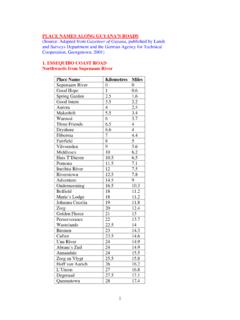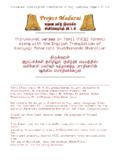Transcription of WHERE TO SEE THE MONARCHS IN CALIFORNIA
1 WHERE WHERE TTO SEE O SEE THE MONARCHSTHE MONARCHSIN CALIFORNIAIN CALIFORNIAT wenty-five Selected SitesDesigned, Written, and Compiled by David MarriottFounder and Executive Director of Education and ResearchEdited byMia Monroe, Chair, Board of DirectorsWaiter Sakal, PresidentDonna Marriott, Assistant EditorPublished by the Monarch ProgramCopyright CALIFORNIA Monarch Studies. , 1997 (1st Edition)IntroductionThe mystery of migrating monarch butterflies has captured the attentionof people throughout the world.
2 East of the continental divide in NorthAmerica, MONARCHS generally migrate to central Mexico from as far away asOntario, Canada. MONARCHS west of the divide fly to the coast of Californiato spend the winter. They cluster together on tree limbs during the wintermonths in CALIFORNIA by the thousands, and in Central Mexico by the CALIFORNIA , migrating MONARCHS begin appearing along the coast inOctober. There are over 300 overwintering sites from south of Ensenada,Baja CALIFORNIA , to north of San Francisco, in Sonoma County.
3 By mid-November, most MONARCHS have chosen their winter homes. The butterfliesdiapause (hibernate) for several months. In late January warmer days and theadvent of spring stimulate mating activity. Female MONARCHS are the first todisperse from overwintering sites. They fly inland, looking for early sproutsof milkweed (Asciepias species) to deposit their eggs. By early March, over-wintering sites are overwintering sites in CALIFORNIA are on private property and noteasily accessible to the general public.
4 The Monarch Program recommendspublic viewing at the overwintering sites listed below. The time to see thegreatest numbers of butterflies is mid-November to mid-December. In lateDecember through January, some MONARCHS shift to other sites, or disperse,others die. However, some sites may have butterflies into early March. Allpopulations are estimates for the 1997/98 the directions to the sites below and look on the southeast sideof the roosting trees. Many listings are on park grounds, thus, a docent orranger may direct you to the roosting trees.
5 On cool days, the MONARCHS willlook like leaves with their wings closed, hanging from tree branches. Asunny afternoon is a good time to visit a site if you do not know WHERE theroosting trees are located. In the late afternoon, you can follow the mon-archs' flight to their selected Cycle and Autumn Migration Movements: MONARCHS thatemerge in late August through October and migrate to their chosenoverwintering destinations may live 7 or 8 months. Their "children"and succeeding generations only live 4-5 weeks.
6 By the time the 4thor 5th generation emerge, it will be September again and these great-great grandchildren will migrate and live through the winter as adultbutterflies. This is a good example of strategy for survival since nativelarval plants are dormant throughout the winter months. In the latespring and summer months, the time from egg to butterfly is about 4weeks: egg (4-6 days); caterpillar (12-16 days); chrysalis (9-12 days). CountyPopulationSiteTwenty-five Selected SitesPopulation estimates are based on multiple years of data; including earlyautumnal migration reports this season, and our 1997 reports from volunteerswho monitored summer breeding habitats west of the Rockies.
7 Listings begin atthe southern sites near the Mexican border, and continue to the northernmostrange, in Sonoma County. Overwintering habitats in Baja CALIFORNIA , Mexicohave been excluded since they are on private property. All sites in Californiawere carefully chosen for easy access onto public property, to foster familyevents, and educational activities. Please respect all parking and trespassing lawsnear overwintering ParkSan Diego900 Presidio Park is located on a hill above Old Town State Historic Park and isaccessible from numerous exits near the junction of Interstate 5 and 8.
8 FromTayor St., take Chestnut St. and turn left on Presidio Dr. Travel to the top of thehill and turn left on Cosoy Way. The MONARCHS roost in the Canary Island Pinetrees along each side of Cosoy Way. In November, the butterflies often roost inthe eucalyptus trees between Serra Historical Museum and the pine trees (nofee). CampusSan Diego4,500 The eucalyptus groves on the UCSD campus have been the winter home tomonarchs long before the campus was founded. Sightings date back to the1950's.
9 This year's population estimate includes two sites. The main site is locat-ed near the Mandeville Performing Arts Center. Take La Jolla Village Dr. westfrom Interstate 5. Turn right on Gilman Dr. and continue through the UCSDG ilman entrance. Turn left on Mandeville Ln. The MONARCHS are located in euca-lyptus trees along the blue screen art sculpture (parking fee). Another UCSD siteis located by the UCSD Coast Apartments. Continue on La Jolla Village Dr.,traveling right onto North Torrey Pines Rd.
10 ,turn left on La Jolla Shores Dr., andturn left on Azul St. The MONARCHS are located in the eucalyptus grove off AzulSt. (no parking 9:00 AM - 2:00 PM, except Sunday, otherwise no fee). GroveSan Diego900 The Carlsbad Hosp Grove was once a very large overwintering site beforetree cutting and development. From Interstate 5, go east on Carlsbad Village Dr.,left on Monroe St., right on Hosp Way, and turn left at the top of the hill on GroveAve. Park in the visitor lot and continue walking on Grove Way to the eucalyp-tus grove at the end of the street.





